How Renaissance and Reformation Contributed to Stronger States
VerifiedAdded on 2023/06/18
|12
|4115
|121
Essay
AI Summary
This essay examines the intertwined relationship between the Renaissance and Reformation periods and their impact on strengthening states in Europe. Beginning with an overview of both movements, it traces their origins in Italy and the subsequent spread throughout Europe. The Renaissance, characterized by a revival of classical learning and artistic innovation, fostered a new spirit of individualism and humanism, while the Reformation challenged the authority of the Catholic Church and led to the rise of Protestantism. The essay details how the Renaissance spurred artistic and intellectual growth, contributing to advancements in literature, art, and science, and how the Reformation prompted religious and political reforms, leading to greater state autonomy. Both movements fostered critical thinking, increased literacy, and reshaped societal values, ultimately contributing to the consolidation of state power and the emergence of modern European nations. Desklib provides further resources, including past papers and solved assignments, for students studying these transformative periods.
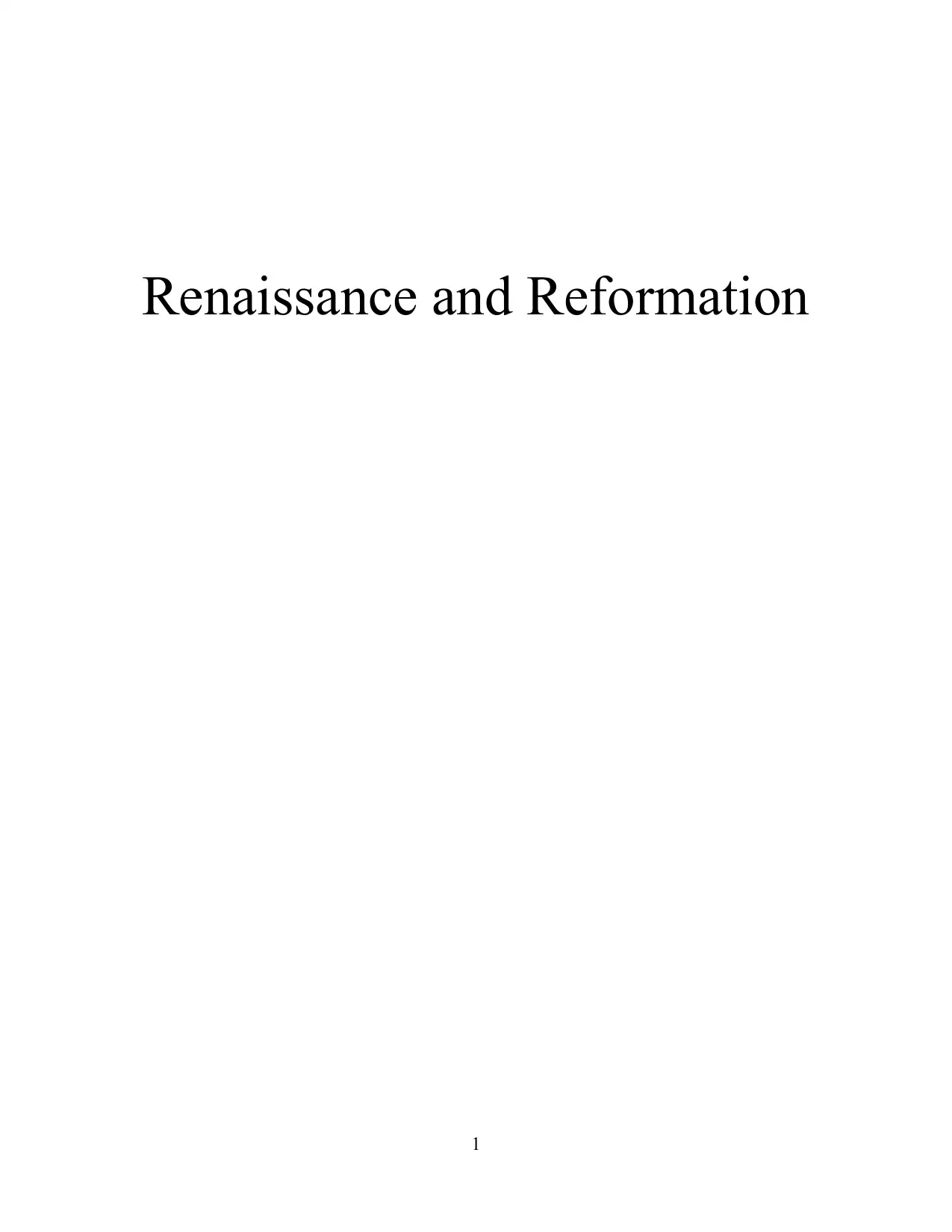
Renaissance and Reformation
1
1
Paraphrase This Document
Need a fresh take? Get an instant paraphrase of this document with our AI Paraphraser
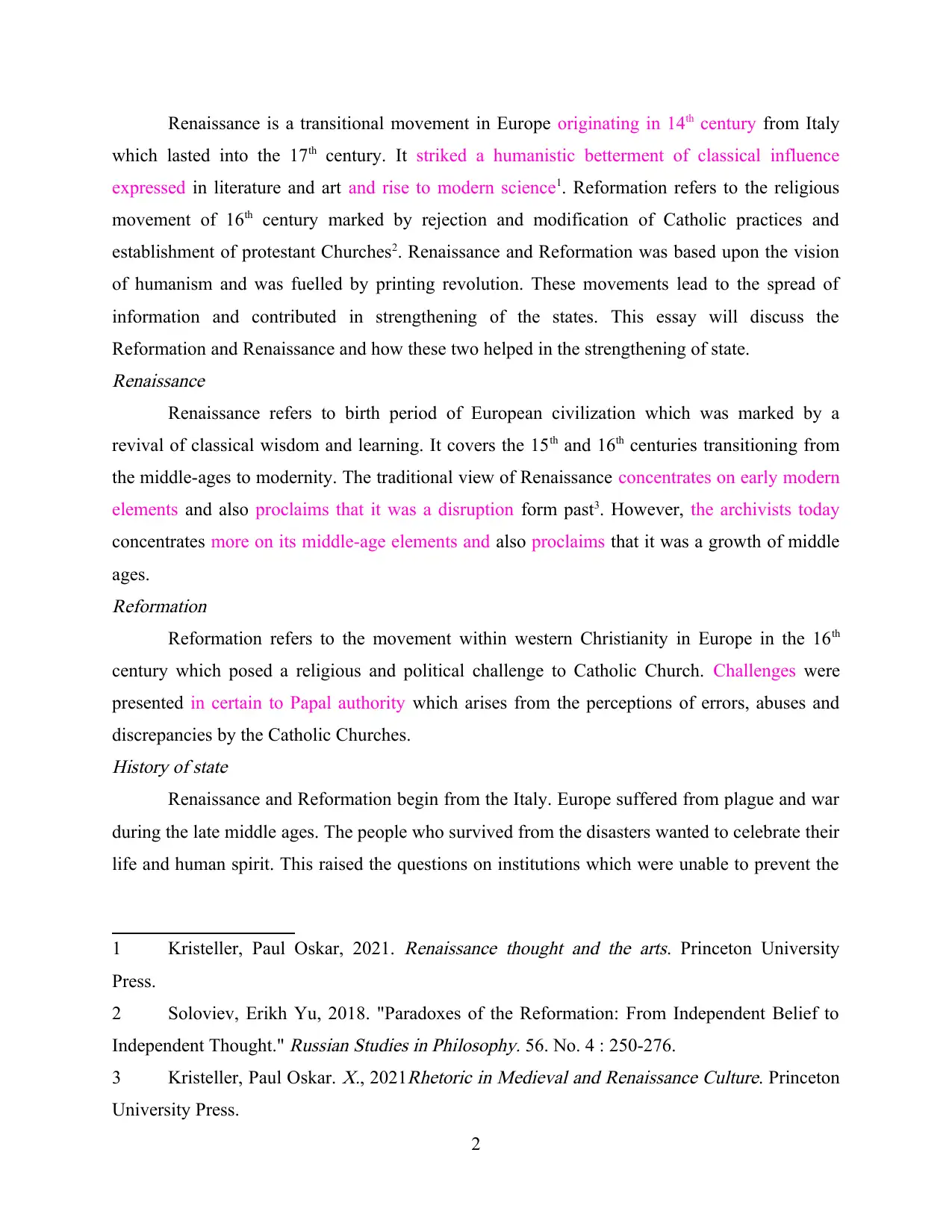
Renaissance is a transitional movement in Europe originating in 14th century from Italy
which lasted into the 17th century. It striked a humanistic betterment of classical influence
expressed in literature and art and rise to modern science1. Reformation refers to the religious
movement of 16th century marked by rejection and modification of Catholic practices and
establishment of protestant Churches2. Renaissance and Reformation was based upon the vision
of humanism and was fuelled by printing revolution. These movements lead to the spread of
information and contributed in strengthening of the states. This essay will discuss the
Reformation and Renaissance and how these two helped in the strengthening of state.Renaissance
Renaissance refers to birth period of European civilization which was marked by a
revival of classical wisdom and learning. It covers the 15th and 16th centuries transitioning from
the middle-ages to modernity. The traditional view of Renaissance concentrates on early modern
elements and also proclaims that it was a disruption form past3. However, the archivists today
concentrates more on its middle-age elements and also proclaims that it was a growth of middle
ages.Reformation
Reformation refers to the movement within western Christianity in Europe in the 16th
century which posed a religious and political challenge to Catholic Church. Challenges were
presented in certain to Papal authority which arises from the perceptions of errors, abuses and
discrepancies by the Catholic Churches.History of state
Renaissance and Reformation begin from the Italy. Europe suffered from plague and war
during the late middle ages. The people who survived from the disasters wanted to celebrate their
life and human spirit. This raised the questions on institutions which were unable to prevent the
1 Kristeller, Paul Oskar, 2021.
Renaissance thought and the arts. Princeton University
Press.
2 Soloviev, Erikh Yu, 2018. "Paradoxes of the Reformation: From Independent Belief to
Independent Thought."
Russian Studies in Philosophy. 56. No. 4 : 250-276.
3 Kristeller, Paul Oskar.
X., 2021
Rhetoric in Medieval and Renaissance Culture. Princeton
University Press.
2
which lasted into the 17th century. It striked a humanistic betterment of classical influence
expressed in literature and art and rise to modern science1. Reformation refers to the religious
movement of 16th century marked by rejection and modification of Catholic practices and
establishment of protestant Churches2. Renaissance and Reformation was based upon the vision
of humanism and was fuelled by printing revolution. These movements lead to the spread of
information and contributed in strengthening of the states. This essay will discuss the
Reformation and Renaissance and how these two helped in the strengthening of state.Renaissance
Renaissance refers to birth period of European civilization which was marked by a
revival of classical wisdom and learning. It covers the 15th and 16th centuries transitioning from
the middle-ages to modernity. The traditional view of Renaissance concentrates on early modern
elements and also proclaims that it was a disruption form past3. However, the archivists today
concentrates more on its middle-age elements and also proclaims that it was a growth of middle
ages.Reformation
Reformation refers to the movement within western Christianity in Europe in the 16th
century which posed a religious and political challenge to Catholic Church. Challenges were
presented in certain to Papal authority which arises from the perceptions of errors, abuses and
discrepancies by the Catholic Churches.History of state
Renaissance and Reformation begin from the Italy. Europe suffered from plague and war
during the late middle ages. The people who survived from the disasters wanted to celebrate their
life and human spirit. This raised the questions on institutions which were unable to prevent the
1 Kristeller, Paul Oskar, 2021.
Renaissance thought and the arts. Princeton University
Press.
2 Soloviev, Erikh Yu, 2018. "Paradoxes of the Reformation: From Independent Belief to
Independent Thought."
Russian Studies in Philosophy. 56. No. 4 : 250-276.
3 Kristeller, Paul Oskar.
X., 2021
Rhetoric in Medieval and Renaissance Culture. Princeton
University Press.
2
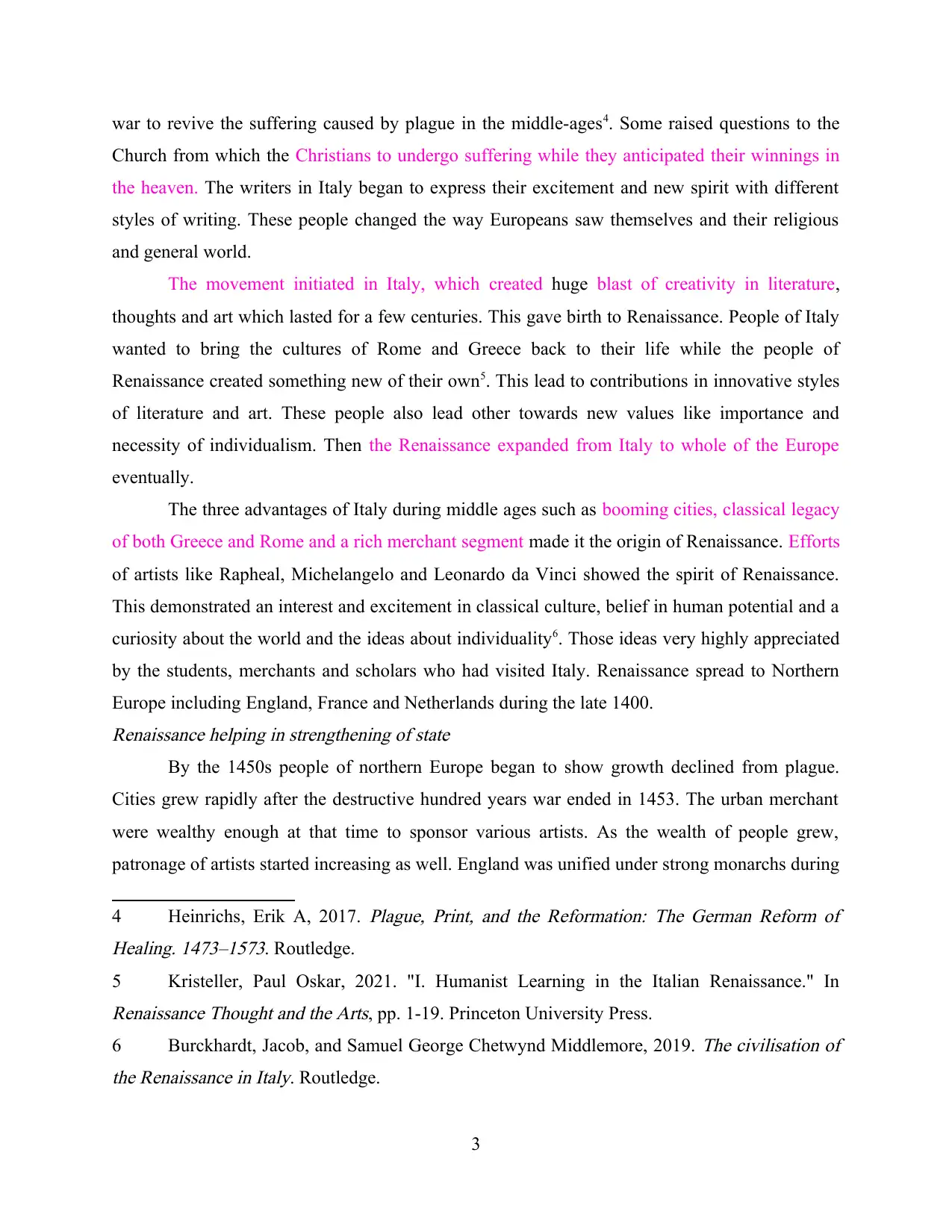
war to revive the suffering caused by plague in the middle-ages4. Some raised questions to the
Church from which the Christians to undergo suffering while they anticipated their winnings in
the heaven. The writers in Italy began to express their excitement and new spirit with different
styles of writing. These people changed the way Europeans saw themselves and their religious
and general world.
The movement initiated in Italy, which created huge blast of creativity in literature,
thoughts and art which lasted for a few centuries. This gave birth to Renaissance. People of Italy
wanted to bring the cultures of Rome and Greece back to their life while the people of
Renaissance created something new of their own5. This lead to contributions in innovative styles
of literature and art. These people also lead other towards new values like importance and
necessity of individualism. Then the Renaissance expanded from Italy to whole of the Europe
eventually.
The three advantages of Italy during middle ages such as booming cities, classical legacy
of both Greece and Rome and a rich merchant segment made it the origin of Renaissance. Efforts
of artists like Rapheal, Michelangelo and Leonardo da Vinci showed the spirit of Renaissance.
This demonstrated an interest and excitement in classical culture, belief in human potential and a
curiosity about the world and the ideas about individuality6. Those ideas very highly appreciated
by the students, merchants and scholars who had visited Italy. Renaissance spread to Northern
Europe including England, France and Netherlands during the late 1400.Renaissance helping in strengthening of state
By the 1450s people of northern Europe began to show growth declined from plague.
Cities grew rapidly after the destructive hundred years war ended in 1453. The urban merchant
were wealthy enough at that time to sponsor various artists. As the wealth of people grew,
patronage of artists started increasing as well. England was unified under strong monarchs during
4 Heinrichs, Erik A, 2017.
Plague, Print, and the Reformation: The German Reform of
Healing. 1473–1573. Routledge.
5 Kristeller, Paul Oskar, 2021. "I. Humanist Learning in the Italian Renaissance." InRenaissance Thought and the Arts, pp. 1-19. Princeton University Press.
6 Burckhardt, Jacob, and Samuel George Chetwynd Middlemore, 2019.
The civilisation of
the Renaissance in Italy. Routledge.
3
Church from which the Christians to undergo suffering while they anticipated their winnings in
the heaven. The writers in Italy began to express their excitement and new spirit with different
styles of writing. These people changed the way Europeans saw themselves and their religious
and general world.
The movement initiated in Italy, which created huge blast of creativity in literature,
thoughts and art which lasted for a few centuries. This gave birth to Renaissance. People of Italy
wanted to bring the cultures of Rome and Greece back to their life while the people of
Renaissance created something new of their own5. This lead to contributions in innovative styles
of literature and art. These people also lead other towards new values like importance and
necessity of individualism. Then the Renaissance expanded from Italy to whole of the Europe
eventually.
The three advantages of Italy during middle ages such as booming cities, classical legacy
of both Greece and Rome and a rich merchant segment made it the origin of Renaissance. Efforts
of artists like Rapheal, Michelangelo and Leonardo da Vinci showed the spirit of Renaissance.
This demonstrated an interest and excitement in classical culture, belief in human potential and a
curiosity about the world and the ideas about individuality6. Those ideas very highly appreciated
by the students, merchants and scholars who had visited Italy. Renaissance spread to Northern
Europe including England, France and Netherlands during the late 1400.Renaissance helping in strengthening of state
By the 1450s people of northern Europe began to show growth declined from plague.
Cities grew rapidly after the destructive hundred years war ended in 1453. The urban merchant
were wealthy enough at that time to sponsor various artists. As the wealth of people grew,
patronage of artists started increasing as well. England was unified under strong monarchs during
4 Heinrichs, Erik A, 2017.
Plague, Print, and the Reformation: The German Reform of
Healing. 1473–1573. Routledge.
5 Kristeller, Paul Oskar, 2021. "I. Humanist Learning in the Italian Renaissance." InRenaissance Thought and the Arts, pp. 1-19. Princeton University Press.
6 Burckhardt, Jacob, and Samuel George Chetwynd Middlemore, 2019.
The civilisation of
the Renaissance in Italy. Routledge.
3
⊘ This is a preview!⊘
Do you want full access?
Subscribe today to unlock all pages.

Trusted by 1+ million students worldwide

that period. The rulers of the state often sponsored arts through purchasing painting by artists and
writers to showed them their support7. Various Italian artists and architects were sponsored by
rulers to rebuild and redecorate their castles and buildings8. These castles, in turn became a
showcase for Renaissance art. Northern Renaissance developed its own character after the ideas
spread out of Italy. The artists were more interested in realism and individuality.
During 1494, as the new rulers claimed southern Italy and launched their invasions
throughout the northern Italy. The wars were dragged but the artists were left on a safer side.
These artists bought the styles and techniques of Italian Renaissance with themselves9. The
artists carried Renaissance ideas back to their home lands.
In between mid-1500s, Renaissance rolled out to whole England which was called as
Elizabethan age. Renaissance was an intense period during middle age for European cultural and
political factors10. Queen Elizabeth-1 was well-educated and spoke various languages. She
supported the development and growth of English literature and art.
Block printing reached form China to Europe during the 13th century. European printers
started using block printing to create full pages to bind into books. However, this process was too
slow and did not satisfy the urge for knowledge, books and information of the Renaissance. In
1440 craftsmen from Germany introduced new technologies which incorporated a lot of
technologies in new ways. Using these technologies, Bible was the first full sized printed book
printed with moveable type of technology11.Legacy of Renaissance
Renaissance was a period of great social change and artistic change. It helped the state in
its strengthening and development. Changes resulted from Renaissance movement includes
changes in art and literature. Writers started using vernacular languages to express their ideas.
7 Panofsky, Erwin, 2018.
Renaissance and renascences in Western art. Routledge.
8 Ramey, Valerie A, 2019. "Ten years after the financial crisis: What have we learned from
the renaissance in fiscal research?."
Journal of Economic Perspective. 33. No. 2 : 89-114.
9 Goldstein, Brian D, 2017.
The roots of urban renaissance. Harvard University Press.
10 Broomhall, Susan, and Andrew Lynch, eds, 2021.
A Cultural History of the Emotions in
the Late Medieval, Reformation, and Renaissance Age. Vol. 3. Cultural Histories.
11 Price, David H, 2020.
In the Beginning Was the Image: Art and the Reformation Bible.
Oxford University Press.
4
writers to showed them their support7. Various Italian artists and architects were sponsored by
rulers to rebuild and redecorate their castles and buildings8. These castles, in turn became a
showcase for Renaissance art. Northern Renaissance developed its own character after the ideas
spread out of Italy. The artists were more interested in realism and individuality.
During 1494, as the new rulers claimed southern Italy and launched their invasions
throughout the northern Italy. The wars were dragged but the artists were left on a safer side.
These artists bought the styles and techniques of Italian Renaissance with themselves9. The
artists carried Renaissance ideas back to their home lands.
In between mid-1500s, Renaissance rolled out to whole England which was called as
Elizabethan age. Renaissance was an intense period during middle age for European cultural and
political factors10. Queen Elizabeth-1 was well-educated and spoke various languages. She
supported the development and growth of English literature and art.
Block printing reached form China to Europe during the 13th century. European printers
started using block printing to create full pages to bind into books. However, this process was too
slow and did not satisfy the urge for knowledge, books and information of the Renaissance. In
1440 craftsmen from Germany introduced new technologies which incorporated a lot of
technologies in new ways. Using these technologies, Bible was the first full sized printed book
printed with moveable type of technology11.Legacy of Renaissance
Renaissance was a period of great social change and artistic change. It helped the state in
its strengthening and development. Changes resulted from Renaissance movement includes
changes in art and literature. Writers started using vernacular languages to express their ideas.
7 Panofsky, Erwin, 2018.
Renaissance and renascences in Western art. Routledge.
8 Ramey, Valerie A, 2019. "Ten years after the financial crisis: What have we learned from
the renaissance in fiscal research?."
Journal of Economic Perspective. 33. No. 2 : 89-114.
9 Goldstein, Brian D, 2017.
The roots of urban renaissance. Harvard University Press.
10 Broomhall, Susan, and Andrew Lynch, eds, 2021.
A Cultural History of the Emotions in
the Late Medieval, Reformation, and Renaissance Age. Vol. 3. Cultural Histories.
11 Price, David H, 2020.
In the Beginning Was the Image: Art and the Reformation Bible.
Oxford University Press.
4
Paraphrase This Document
Need a fresh take? Get an instant paraphrase of this document with our AI Paraphraser
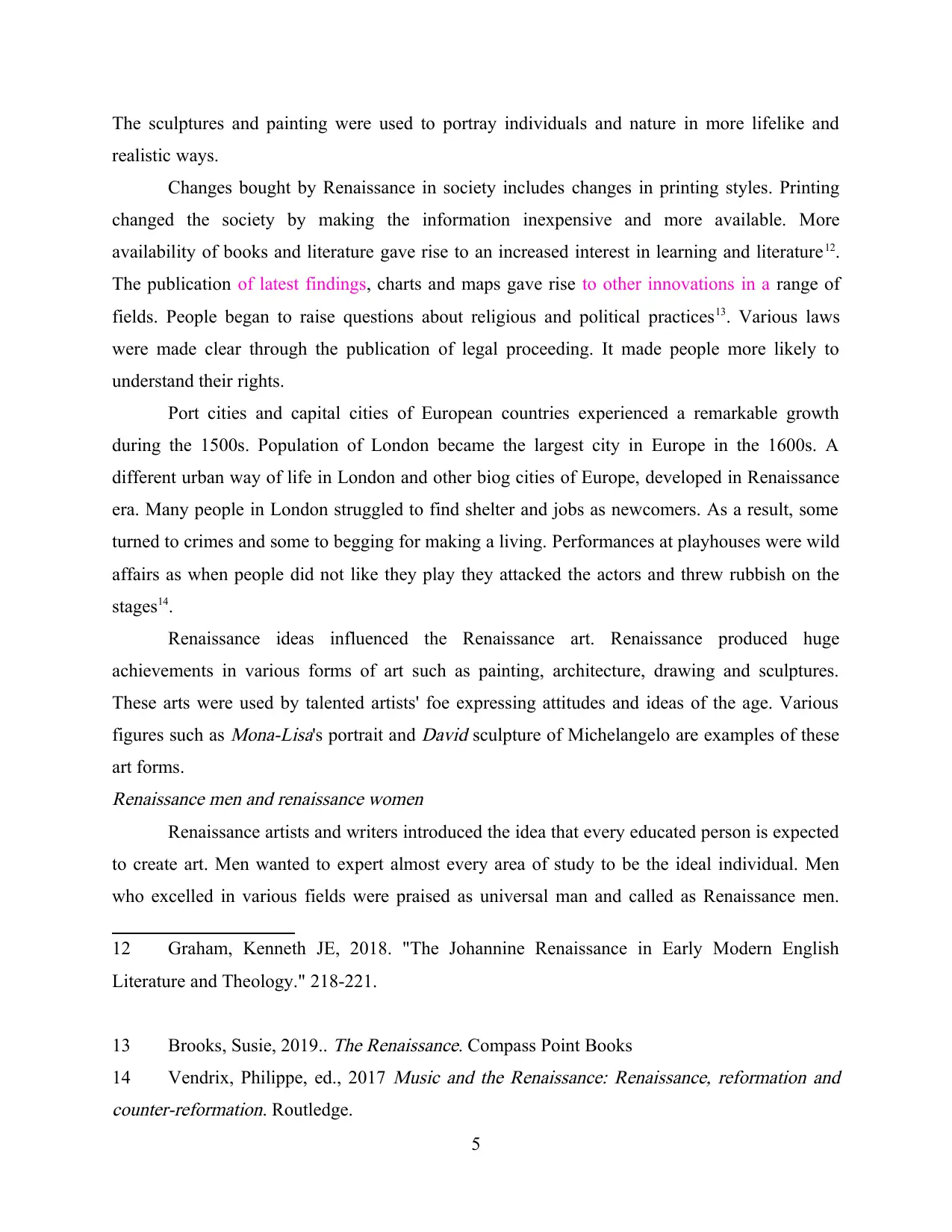
The sculptures and painting were used to portray individuals and nature in more lifelike and
realistic ways.
Changes bought by Renaissance in society includes changes in printing styles. Printing
changed the society by making the information inexpensive and more available. More
availability of books and literature gave rise to an increased interest in learning and literature12.
The publication of latest findings, charts and maps gave rise to other innovations in a range of
fields. People began to raise questions about religious and political practices13. Various laws
were made clear through the publication of legal proceeding. It made people more likely to
understand their rights.
Port cities and capital cities of European countries experienced a remarkable growth
during the 1500s. Population of London became the largest city in Europe in the 1600s. A
different urban way of life in London and other biog cities of Europe, developed in Renaissance
era. Many people in London struggled to find shelter and jobs as newcomers. As a result, some
turned to crimes and some to begging for making a living. Performances at playhouses were wild
affairs as when people did not like they play they attacked the actors and threw rubbish on the
stages14.
Renaissance ideas influenced the Renaissance art. Renaissance produced huge
achievements in various forms of art such as painting, architecture, drawing and sculptures.
These arts were used by talented artists' foe expressing attitudes and ideas of the age. Various
figures such as
Mona-Lisa's portrait and
David sculpture of Michelangelo are examples of these
art forms.Renaissance men and renaissance women
Renaissance artists and writers introduced the idea that every educated person is expected
to create art. Men wanted to expert almost every area of study to be the ideal individual. Men
who excelled in various fields were praised as universal man and called as Renaissance men.
12 Graham, Kenneth JE, 2018. "The Johannine Renaissance in Early Modern English
Literature and Theology." 218-221.
13 Brooks, Susie, 2019..
The Renaissance. Compass Point Books
14 Vendrix, Philippe, ed., 2017
Music and the Renaissance: Renaissance, reformation and
counter-reformation. Routledge.
5
realistic ways.
Changes bought by Renaissance in society includes changes in printing styles. Printing
changed the society by making the information inexpensive and more available. More
availability of books and literature gave rise to an increased interest in learning and literature12.
The publication of latest findings, charts and maps gave rise to other innovations in a range of
fields. People began to raise questions about religious and political practices13. Various laws
were made clear through the publication of legal proceeding. It made people more likely to
understand their rights.
Port cities and capital cities of European countries experienced a remarkable growth
during the 1500s. Population of London became the largest city in Europe in the 1600s. A
different urban way of life in London and other biog cities of Europe, developed in Renaissance
era. Many people in London struggled to find shelter and jobs as newcomers. As a result, some
turned to crimes and some to begging for making a living. Performances at playhouses were wild
affairs as when people did not like they play they attacked the actors and threw rubbish on the
stages14.
Renaissance ideas influenced the Renaissance art. Renaissance produced huge
achievements in various forms of art such as painting, architecture, drawing and sculptures.
These arts were used by talented artists' foe expressing attitudes and ideas of the age. Various
figures such as
Mona-Lisa's portrait and
David sculpture of Michelangelo are examples of these
art forms.Renaissance men and renaissance women
Renaissance artists and writers introduced the idea that every educated person is expected
to create art. Men wanted to expert almost every area of study to be the ideal individual. Men
who excelled in various fields were praised as universal man and called as Renaissance men.
12 Graham, Kenneth JE, 2018. "The Johannine Renaissance in Early Modern English
Literature and Theology." 218-221.
13 Brooks, Susie, 2019..
The Renaissance. Compass Point Books
14 Vendrix, Philippe, ed., 2017
Music and the Renaissance: Renaissance, reformation and
counter-reformation. Routledge.
5
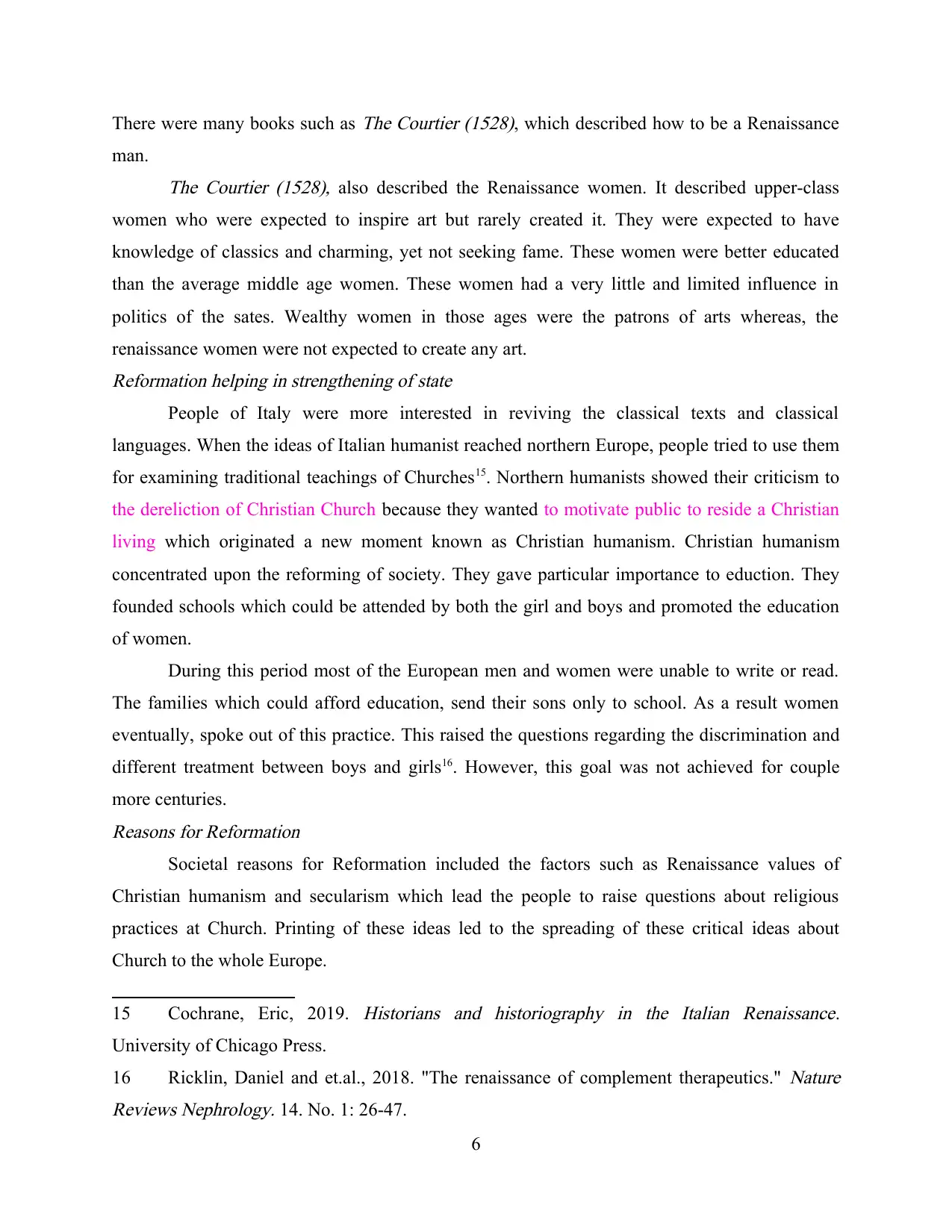
There were many books such as
The Courtier (1528), which described how to be a Renaissance
man. The Courtier (1528), also described the Renaissance women. It described upper-class
women who were expected to inspire art but rarely created it. They were expected to have
knowledge of classics and charming, yet not seeking fame. These women were better educated
than the average middle age women. These women had a very little and limited influence in
politics of the sates. Wealthy women in those ages were the patrons of arts whereas, the
renaissance women were not expected to create any art.Reformation helping in strengthening of state
People of Italy were more interested in reviving the classical texts and classical
languages. When the ideas of Italian humanist reached northern Europe, people tried to use them
for examining traditional teachings of Churches15. Northern humanists showed their criticism to
the dereliction of Christian Church because they wanted to motivate public to reside a Christian
living which originated a new moment known as Christian humanism. Christian humanism
concentrated upon the reforming of society. They gave particular importance to eduction. They
founded schools which could be attended by both the girl and boys and promoted the education
of women.
During this period most of the European men and women were unable to write or read.
The families which could afford education, send their sons only to school. As a result women
eventually, spoke out of this practice. This raised the questions regarding the discrimination and
different treatment between boys and girls16. However, this goal was not achieved for couple
more centuries.Reasons for Reformation
Societal reasons for Reformation included the factors such as Renaissance values of
Christian humanism and secularism which lead the people to raise questions about religious
practices at Church. Printing of these ideas led to the spreading of these critical ideas about
Church to the whole Europe.
15 Cochrane, Eric, 2019.
Historians and historiography in the Italian Renaissance.
University of Chicago Press.
16 Ricklin, Daniel and et.al., 2018. "The renaissance of complement therapeutics."
Nature
Reviews Nephrology. 14. No. 1: 26-47.
6
The Courtier (1528), which described how to be a Renaissance
man. The Courtier (1528), also described the Renaissance women. It described upper-class
women who were expected to inspire art but rarely created it. They were expected to have
knowledge of classics and charming, yet not seeking fame. These women were better educated
than the average middle age women. These women had a very little and limited influence in
politics of the sates. Wealthy women in those ages were the patrons of arts whereas, the
renaissance women were not expected to create any art.Reformation helping in strengthening of state
People of Italy were more interested in reviving the classical texts and classical
languages. When the ideas of Italian humanist reached northern Europe, people tried to use them
for examining traditional teachings of Churches15. Northern humanists showed their criticism to
the dereliction of Christian Church because they wanted to motivate public to reside a Christian
living which originated a new moment known as Christian humanism. Christian humanism
concentrated upon the reforming of society. They gave particular importance to eduction. They
founded schools which could be attended by both the girl and boys and promoted the education
of women.
During this period most of the European men and women were unable to write or read.
The families which could afford education, send their sons only to school. As a result women
eventually, spoke out of this practice. This raised the questions regarding the discrimination and
different treatment between boys and girls16. However, this goal was not achieved for couple
more centuries.Reasons for Reformation
Societal reasons for Reformation included the factors such as Renaissance values of
Christian humanism and secularism which lead the people to raise questions about religious
practices at Church. Printing of these ideas led to the spreading of these critical ideas about
Church to the whole Europe.
15 Cochrane, Eric, 2019.
Historians and historiography in the Italian Renaissance.
University of Chicago Press.
16 Ricklin, Daniel and et.al., 2018. "The renaissance of complement therapeutics."
Nature
Reviews Nephrology. 14. No. 1: 26-47.
6
⊘ This is a preview!⊘
Do you want full access?
Subscribe today to unlock all pages.

Trusted by 1+ million students worldwide
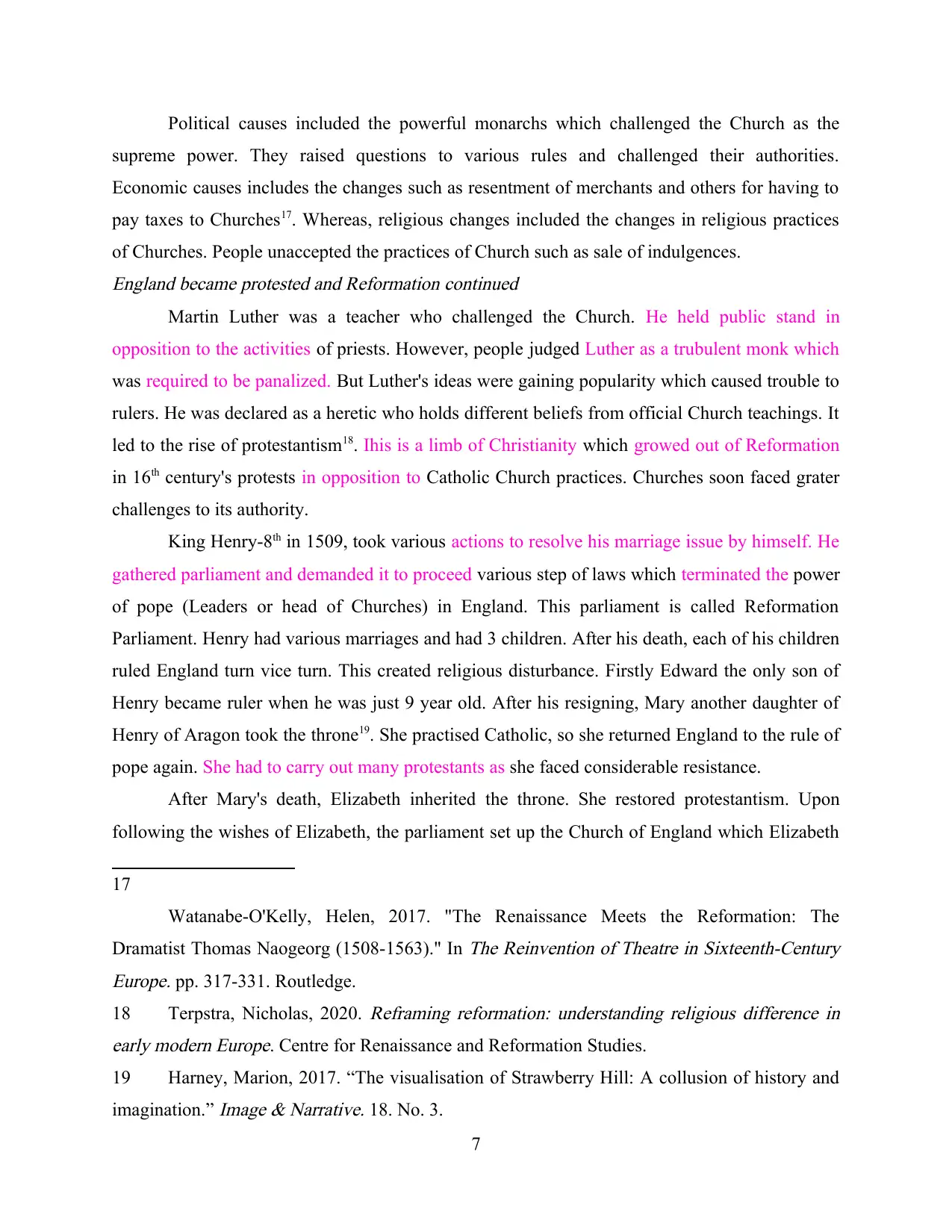
Political causes included the powerful monarchs which challenged the Church as the
supreme power. They raised questions to various rules and challenged their authorities.
Economic causes includes the changes such as resentment of merchants and others for having to
pay taxes to Churches17. Whereas, religious changes included the changes in religious practices
of Churches. People unaccepted the practices of Church such as sale of indulgences.England became protested and Reformation continued
Martin Luther was a teacher who challenged the Church. He held public stand in
opposition to the activities of priests. However, people judged Luther as a trubulent monk which
was required to be panalized. But Luther's ideas were gaining popularity which caused trouble to
rulers. He was declared as a heretic who holds different beliefs from official Church teachings. It
led to the rise of protestantism18. Ihis is a limb of Christianity which growed out of Reformation
in 16th century's protests in opposition to Catholic Church practices. Churches soon faced grater
challenges to its authority.
King Henry-8th in 1509, took various actions to resolve his marriage issue by himself. He
gathered parliament and demanded it to proceed various step of laws which terminated the power
of pope (Leaders or head of Churches) in England. This parliament is called Reformation
Parliament. Henry had various marriages and had 3 children. After his death, each of his children
ruled England turn vice turn. This created religious disturbance. Firstly Edward the only son of
Henry became ruler when he was just 9 year old. After his resigning, Mary another daughter of
Henry of Aragon took the throne19. She practised Catholic, so she returned England to the rule of
pope again. She had to carry out many protestants as she faced considerable resistance.
After Mary's death, Elizabeth inherited the throne. She restored protestantism. Upon
following the wishes of Elizabeth, the parliament set up the Church of England which Elizabeth
17
Watanabe-O'Kelly, Helen, 2017. "The Renaissance Meets the Reformation: The
Dramatist Thomas Naogeorg (1508-1563)." In
The Reinvention of Theatre in Sixteenth-Century
Europe. pp. 317-331. Routledge.
18 Terpstra, Nicholas, 2020.
Reframing reformation: understanding religious difference in
early modern Europe. Centre for Renaissance and Reformation Studies.
19 Harney, Marion, 2017. “The visualisation of Strawberry Hill: A collusion of history and
imagination.”
Image & Narrative. 18. No. 3.
7
supreme power. They raised questions to various rules and challenged their authorities.
Economic causes includes the changes such as resentment of merchants and others for having to
pay taxes to Churches17. Whereas, religious changes included the changes in religious practices
of Churches. People unaccepted the practices of Church such as sale of indulgences.England became protested and Reformation continued
Martin Luther was a teacher who challenged the Church. He held public stand in
opposition to the activities of priests. However, people judged Luther as a trubulent monk which
was required to be panalized. But Luther's ideas were gaining popularity which caused trouble to
rulers. He was declared as a heretic who holds different beliefs from official Church teachings. It
led to the rise of protestantism18. Ihis is a limb of Christianity which growed out of Reformation
in 16th century's protests in opposition to Catholic Church practices. Churches soon faced grater
challenges to its authority.
King Henry-8th in 1509, took various actions to resolve his marriage issue by himself. He
gathered parliament and demanded it to proceed various step of laws which terminated the power
of pope (Leaders or head of Churches) in England. This parliament is called Reformation
Parliament. Henry had various marriages and had 3 children. After his death, each of his children
ruled England turn vice turn. This created religious disturbance. Firstly Edward the only son of
Henry became ruler when he was just 9 year old. After his resigning, Mary another daughter of
Henry of Aragon took the throne19. She practised Catholic, so she returned England to the rule of
pope again. She had to carry out many protestants as she faced considerable resistance.
After Mary's death, Elizabeth inherited the throne. She restored protestantism. Upon
following the wishes of Elizabeth, the parliament set up the Church of England which Elizabeth
17
Watanabe-O'Kelly, Helen, 2017. "The Renaissance Meets the Reformation: The
Dramatist Thomas Naogeorg (1508-1563)." In
The Reinvention of Theatre in Sixteenth-Century
Europe. pp. 317-331. Routledge.
18 Terpstra, Nicholas, 2020.
Reframing reformation: understanding religious difference in
early modern Europe. Centre for Renaissance and Reformation Studies.
19 Harney, Marion, 2017. “The visualisation of Strawberry Hill: A collusion of history and
imagination.”
Image & Narrative. 18. No. 3.
7
Paraphrase This Document
Need a fresh take? Get an instant paraphrase of this document with our AI Paraphraser
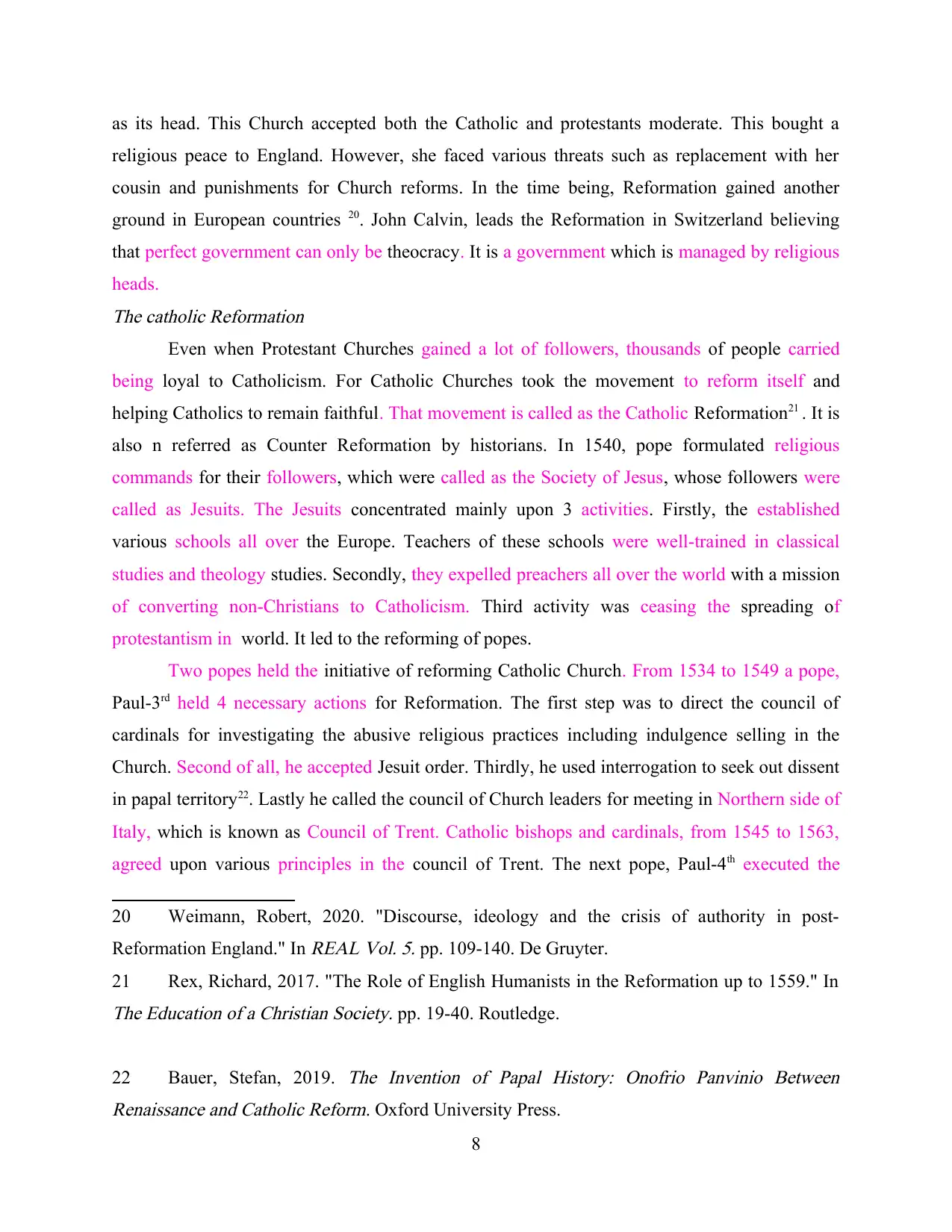
as its head. This Church accepted both the Catholic and protestants moderate. This bought a
religious peace to England. However, she faced various threats such as replacement with her
cousin and punishments for Church reforms. In the time being, Reformation gained another
ground in European countries 20. John Calvin, leads the Reformation in Switzerland believing
that perfect government can only be theocracy. It is a government which is managed by religious
heads.The catholic Reformation
Even when Protestant Churches gained a lot of followers, thousands of people carried
being loyal to Catholicism. For Catholic Churches took the movement to reform itself and
helping Catholics to remain faithful. That movement is called as the Catholic Reformation21 . It is
also n referred as Counter Reformation by historians. In 1540, pope formulated religious
commands for their followers, which were called as the Society of Jesus, whose followers were
called as Jesuits. The Jesuits concentrated mainly upon 3 activities. Firstly, the established
various schools all over the Europe. Teachers of these schools were well-trained in classical
studies and theology studies. Secondly, they expelled preachers all over the world with a mission
of converting non-Christians to Catholicism. Third activity was ceasing the spreading of
protestantism in world. It led to the reforming of popes.
Two popes held the initiative of reforming Catholic Church. From 1534 to 1549 a pope,
Paul-3rd held 4 necessary actions for Reformation. The first step was to direct the council of
cardinals for investigating the abusive religious practices including indulgence selling in the
Church. Second of all, he accepted Jesuit order. Thirdly, he used interrogation to seek out dissent
in papal territory22. Lastly he called the council of Church leaders for meeting in Northern side of
Italy, which is known as Council of Trent. Catholic bishops and cardinals, from 1545 to 1563,
agreed upon various principles in the council of Trent. The next pope, Paul-4th executed the
20 Weimann, Robert, 2020. "Discourse, ideology and the crisis of authority in post-
Reformation England." In
REAL Vol. 5. pp. 109-140. De Gruyter.
21 Rex, Richard, 2017. "The Role of English Humanists in the Reformation up to 1559." InThe Education of a Christian Society. pp. 19-40. Routledge.
22 Bauer, Stefan, 2019.
The Invention of Papal History: Onofrio Panvinio Between
Renaissance and Catholic Reform. Oxford University Press.
8
religious peace to England. However, she faced various threats such as replacement with her
cousin and punishments for Church reforms. In the time being, Reformation gained another
ground in European countries 20. John Calvin, leads the Reformation in Switzerland believing
that perfect government can only be theocracy. It is a government which is managed by religious
heads.The catholic Reformation
Even when Protestant Churches gained a lot of followers, thousands of people carried
being loyal to Catholicism. For Catholic Churches took the movement to reform itself and
helping Catholics to remain faithful. That movement is called as the Catholic Reformation21 . It is
also n referred as Counter Reformation by historians. In 1540, pope formulated religious
commands for their followers, which were called as the Society of Jesus, whose followers were
called as Jesuits. The Jesuits concentrated mainly upon 3 activities. Firstly, the established
various schools all over the Europe. Teachers of these schools were well-trained in classical
studies and theology studies. Secondly, they expelled preachers all over the world with a mission
of converting non-Christians to Catholicism. Third activity was ceasing the spreading of
protestantism in world. It led to the reforming of popes.
Two popes held the initiative of reforming Catholic Church. From 1534 to 1549 a pope,
Paul-3rd held 4 necessary actions for Reformation. The first step was to direct the council of
cardinals for investigating the abusive religious practices including indulgence selling in the
Church. Second of all, he accepted Jesuit order. Thirdly, he used interrogation to seek out dissent
in papal territory22. Lastly he called the council of Church leaders for meeting in Northern side of
Italy, which is known as Council of Trent. Catholic bishops and cardinals, from 1545 to 1563,
agreed upon various principles in the council of Trent. The next pope, Paul-4th executed the
20 Weimann, Robert, 2020. "Discourse, ideology and the crisis of authority in post-
Reformation England." In
REAL Vol. 5. pp. 109-140. De Gruyter.
21 Rex, Richard, 2017. "The Role of English Humanists in the Reformation up to 1559." InThe Education of a Christian Society. pp. 19-40. Routledge.
22 Bauer, Stefan, 2019.
The Invention of Papal History: Onofrio Panvinio Between
Renaissance and Catholic Reform. Oxford University Press.
8
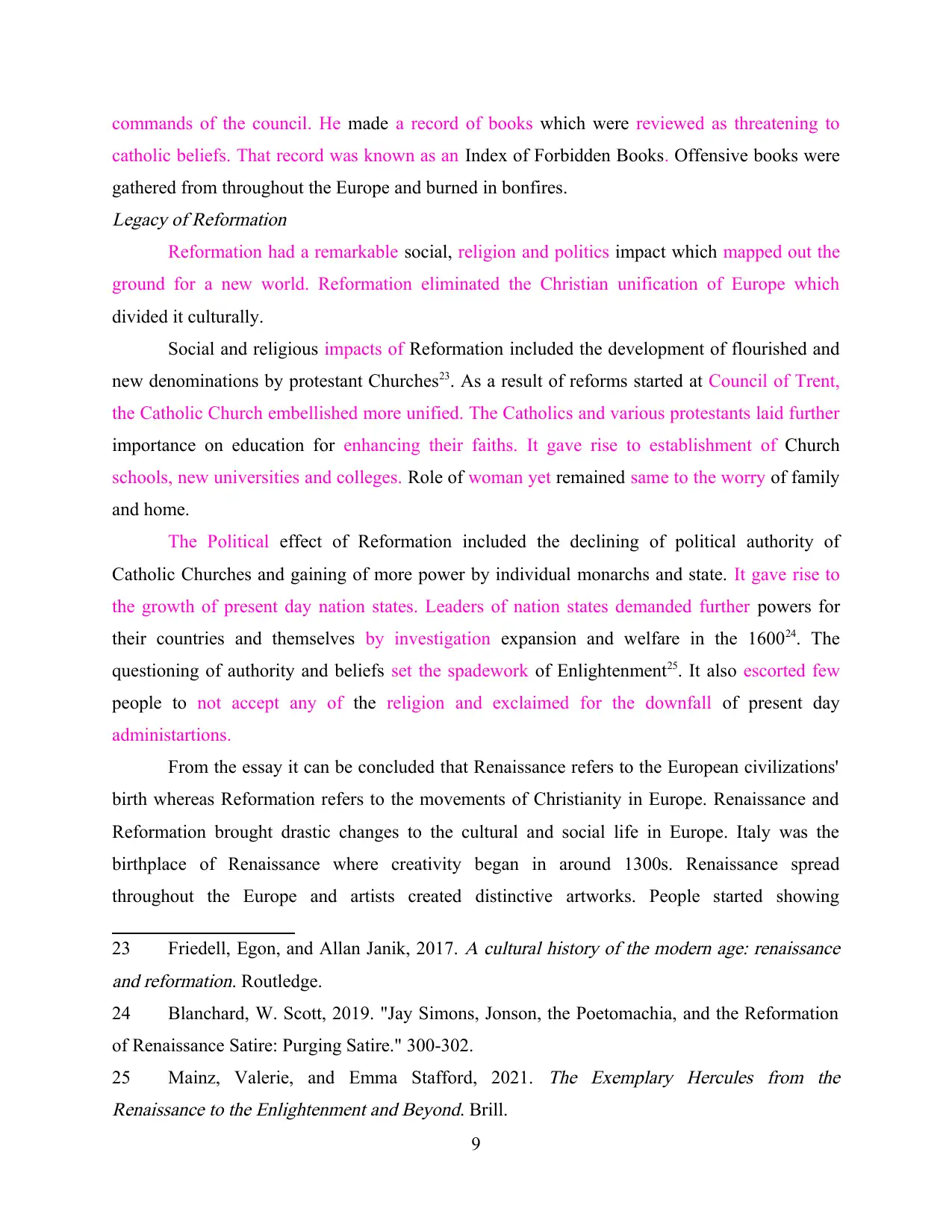
commands of the council. He made a record of books which were reviewed as threatening to
catholic beliefs. That record was known as an Index of Forbidden Books. Offensive books were
gathered from throughout the Europe and burned in bonfires.Legacy of Reformation
Reformation had a remarkable social, religion and politics impact which mapped out the
ground for a new world. Reformation eliminated the Christian unification of Europe which
divided it culturally.
Social and religious impacts of Reformation included the development of flourished and
new denominations by protestant Churches23. As a result of reforms started at Council of Trent,
the Catholic Church embellished more unified. The Catholics and various protestants laid further
importance on education for enhancing their faiths. It gave rise to establishment of Church
schools, new universities and colleges. Role of woman yet remained same to the worry of family
and home.
The Political effect of Reformation included the declining of political authority of
Catholic Churches and gaining of more power by individual monarchs and state. It gave rise to
the growth of present day nation states. Leaders of nation states demanded further powers for
their countries and themselves by investigation expansion and welfare in the 160024. The
questioning of authority and beliefs set the spadework of Enlightenment25. It also escorted few
people to not accept any of the religion and exclaimed for the downfall of present day
administartions.
From the essay it can be concluded that Renaissance refers to the European civilizations'
birth whereas Reformation refers to the movements of Christianity in Europe. Renaissance and
Reformation brought drastic changes to the cultural and social life in Europe. Italy was the
birthplace of Renaissance where creativity began in around 1300s. Renaissance spread
throughout the Europe and artists created distinctive artworks. People started showing
23 Friedell, Egon, and Allan Janik, 2017.
A cultural history of the modern age: renaissance
and reformation. Routledge.
24 Blanchard, W. Scott, 2019. "Jay Simons, Jonson, the Poetomachia, and the Reformation
of Renaissance Satire: Purging Satire." 300-302.
25 Mainz, Valerie, and Emma Stafford, 2021.
The Exemplary Hercules from the
Renaissance to the Enlightenment and Beyond. Brill.
9
catholic beliefs. That record was known as an Index of Forbidden Books. Offensive books were
gathered from throughout the Europe and burned in bonfires.Legacy of Reformation
Reformation had a remarkable social, religion and politics impact which mapped out the
ground for a new world. Reformation eliminated the Christian unification of Europe which
divided it culturally.
Social and religious impacts of Reformation included the development of flourished and
new denominations by protestant Churches23. As a result of reforms started at Council of Trent,
the Catholic Church embellished more unified. The Catholics and various protestants laid further
importance on education for enhancing their faiths. It gave rise to establishment of Church
schools, new universities and colleges. Role of woman yet remained same to the worry of family
and home.
The Political effect of Reformation included the declining of political authority of
Catholic Churches and gaining of more power by individual monarchs and state. It gave rise to
the growth of present day nation states. Leaders of nation states demanded further powers for
their countries and themselves by investigation expansion and welfare in the 160024. The
questioning of authority and beliefs set the spadework of Enlightenment25. It also escorted few
people to not accept any of the religion and exclaimed for the downfall of present day
administartions.
From the essay it can be concluded that Renaissance refers to the European civilizations'
birth whereas Reformation refers to the movements of Christianity in Europe. Renaissance and
Reformation brought drastic changes to the cultural and social life in Europe. Italy was the
birthplace of Renaissance where creativity began in around 1300s. Renaissance spread
throughout the Europe and artists created distinctive artworks. People started showing
23 Friedell, Egon, and Allan Janik, 2017.
A cultural history of the modern age: renaissance
and reformation. Routledge.
24 Blanchard, W. Scott, 2019. "Jay Simons, Jonson, the Poetomachia, and the Reformation
of Renaissance Satire: Purging Satire." 300-302.
25 Mainz, Valerie, and Emma Stafford, 2021.
The Exemplary Hercules from the
Renaissance to the Enlightenment and Beyond. Brill.
9
⊘ This is a preview!⊘
Do you want full access?
Subscribe today to unlock all pages.

Trusted by 1+ million students worldwide
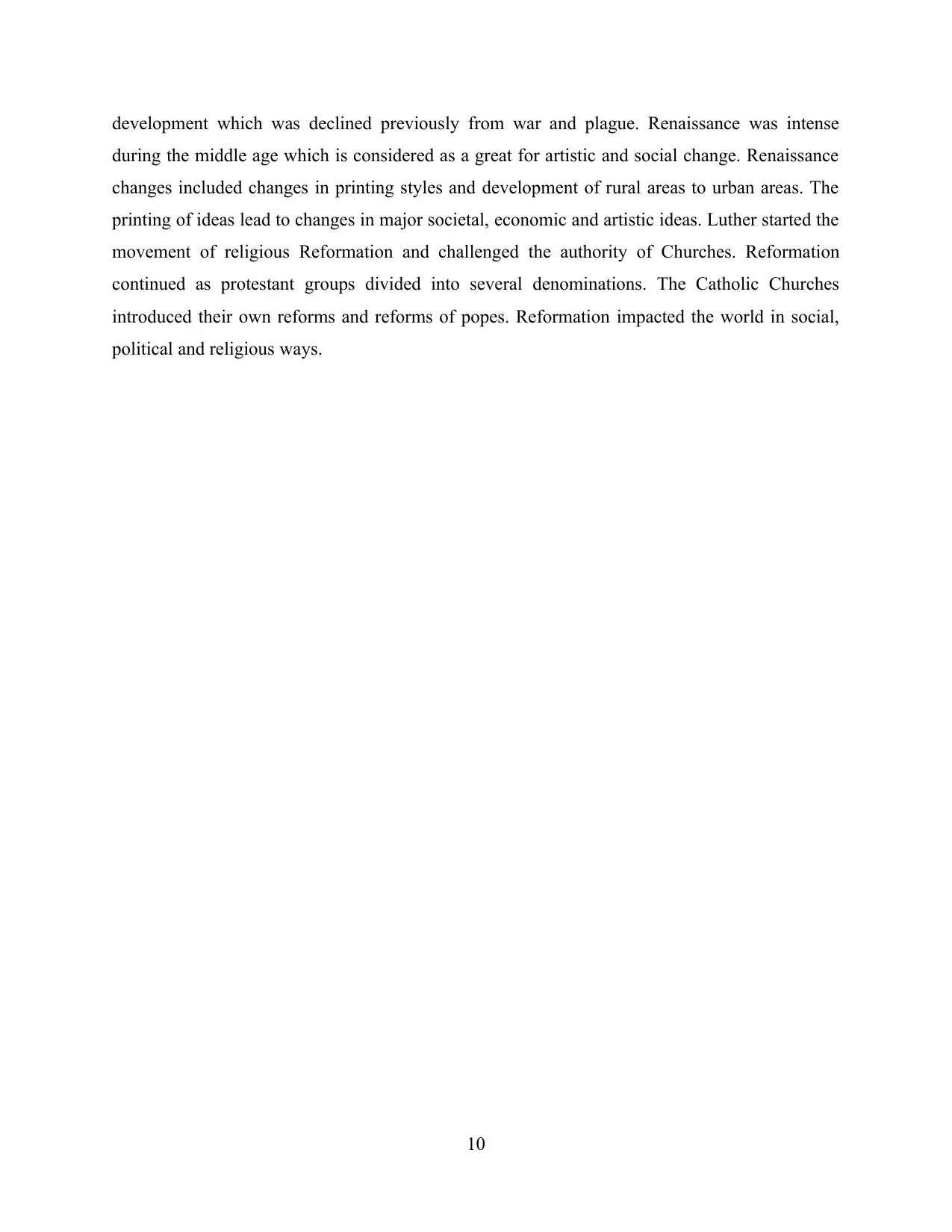
development which was declined previously from war and plague. Renaissance was intense
during the middle age which is considered as a great for artistic and social change. Renaissance
changes included changes in printing styles and development of rural areas to urban areas. The
printing of ideas lead to changes in major societal, economic and artistic ideas. Luther started the
movement of religious Reformation and challenged the authority of Churches. Reformation
continued as protestant groups divided into several denominations. The Catholic Churches
introduced their own reforms and reforms of popes. Reformation impacted the world in social,
political and religious ways.
10
during the middle age which is considered as a great for artistic and social change. Renaissance
changes included changes in printing styles and development of rural areas to urban areas. The
printing of ideas lead to changes in major societal, economic and artistic ideas. Luther started the
movement of religious Reformation and challenged the authority of Churches. Reformation
continued as protestant groups divided into several denominations. The Catholic Churches
introduced their own reforms and reforms of popes. Reformation impacted the world in social,
political and religious ways.
10
Paraphrase This Document
Need a fresh take? Get an instant paraphrase of this document with our AI Paraphraser
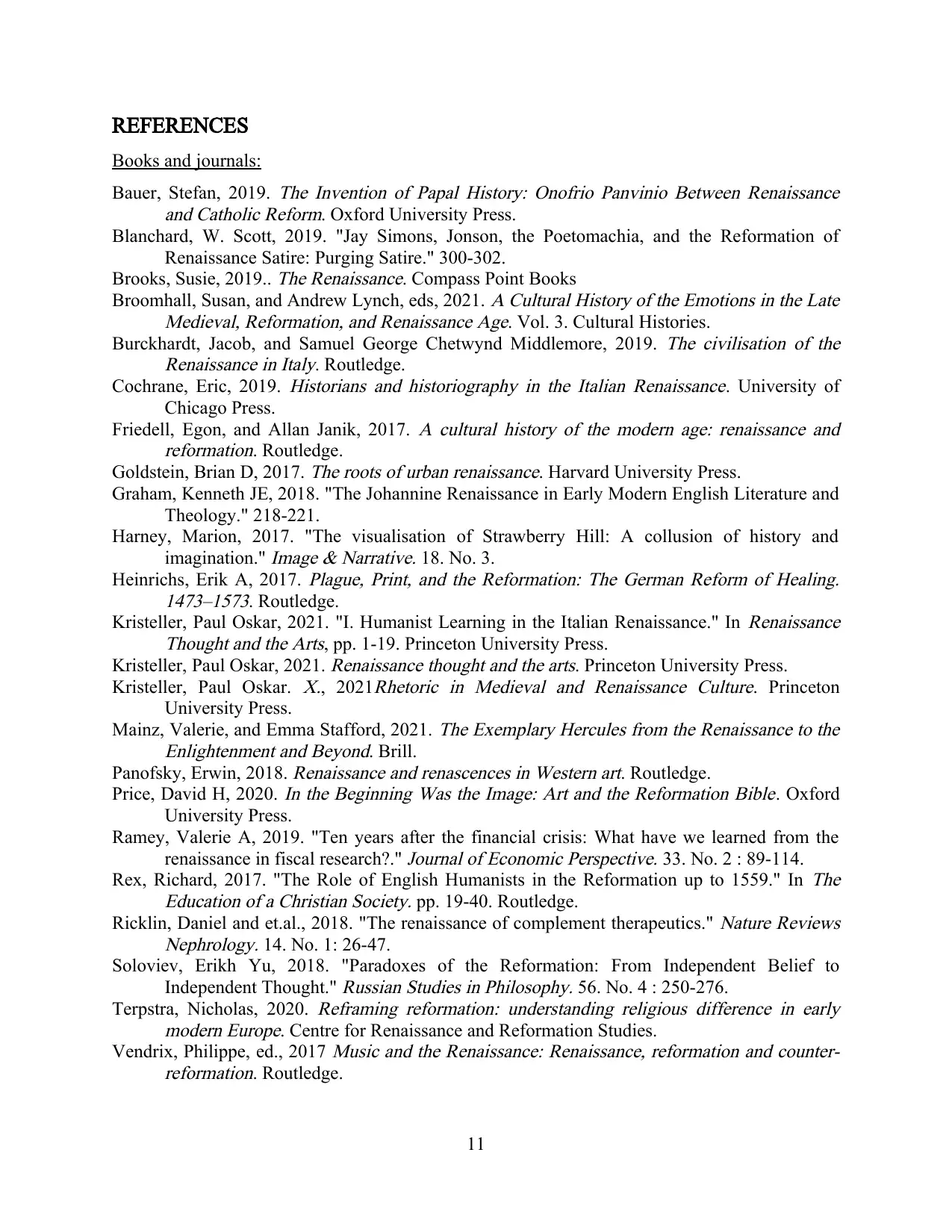
REFERENCES
Books and journals:
Bauer, Stefan, 2019.
The Invention of Papal History: Onofrio Panvinio Between Renaissance
and Catholic Reform. Oxford University Press.
Blanchard, W. Scott, 2019. "Jay Simons, Jonson, the Poetomachia, and the Reformation of
Renaissance Satire: Purging Satire." 300-302.
Brooks, Susie, 2019..
The Renaissance. Compass Point Books
Broomhall, Susan, and Andrew Lynch, eds, 2021.
A Cultural History of the Emotions in the Late
Medieval, Reformation, and Renaissance Age. Vol. 3. Cultural Histories.
Burckhardt, Jacob, and Samuel George Chetwynd Middlemore, 2019.
The civilisation of the
Renaissance in Italy. Routledge.
Cochrane, Eric, 2019.
Historians and historiography in the Italian Renaissance. University of
Chicago Press.
Friedell, Egon, and Allan Janik, 2017.
A cultural history of the modern age: renaissance and
reformation. Routledge.
Goldstein, Brian D, 2017.
The roots of urban renaissance. Harvard University Press.
Graham, Kenneth JE, 2018. "The Johannine Renaissance in Early Modern English Literature and
Theology." 218-221.
Harney, Marion, 2017. "The visualisation of Strawberry Hill: A collusion of history and
imagination."
Image & Narrative. 18. No. 3.
Heinrichs, Erik A, 2017.
Plague, Print, and the Reformation: The German Reform of Healing.
1473–1573. Routledge.
Kristeller, Paul Oskar, 2021. "I. Humanist Learning in the Italian Renaissance." In
Renaissance
Thought and the Arts, pp. 1-19. Princeton University Press.
Kristeller, Paul Oskar, 2021.
Renaissance thought and the arts. Princeton University Press.
Kristeller, Paul Oskar.
X., 2021
Rhetoric in Medieval and Renaissance Culture. Princeton
University Press.
Mainz, Valerie, and Emma Stafford, 2021.
The Exemplary Hercules from the Renaissance to the
Enlightenment and Beyond. Brill.
Panofsky, Erwin, 2018.
Renaissance and renascences in Western art. Routledge.
Price, David H, 2020.
In the Beginning Was the Image: Art and the Reformation Bible. Oxford
University Press.
Ramey, Valerie A, 2019. "Ten years after the financial crisis: What have we learned from the
renaissance in fiscal research?."
Journal of Economic Perspective. 33. No. 2 : 89-114.
Rex, Richard, 2017. "The Role of English Humanists in the Reformation up to 1559." In
The
Education of a Christian Society. pp. 19-40. Routledge.
Ricklin, Daniel and et.al., 2018. "The renaissance of complement therapeutics."
Nature Reviews
Nephrology. 14. No. 1: 26-47.
Soloviev, Erikh Yu, 2018. "Paradoxes of the Reformation: From Independent Belief to
Independent Thought."
Russian Studies in Philosophy. 56. No. 4 : 250-276.
Terpstra, Nicholas, 2020.
Reframing reformation: understanding religious difference in early
modern Europe. Centre for Renaissance and Reformation Studies.
Vendrix, Philippe, ed., 2017
Music and the Renaissance: Renaissance, reformation and counter-
reformation. Routledge.
11
Books and journals:
Bauer, Stefan, 2019.
The Invention of Papal History: Onofrio Panvinio Between Renaissance
and Catholic Reform. Oxford University Press.
Blanchard, W. Scott, 2019. "Jay Simons, Jonson, the Poetomachia, and the Reformation of
Renaissance Satire: Purging Satire." 300-302.
Brooks, Susie, 2019..
The Renaissance. Compass Point Books
Broomhall, Susan, and Andrew Lynch, eds, 2021.
A Cultural History of the Emotions in the Late
Medieval, Reformation, and Renaissance Age. Vol. 3. Cultural Histories.
Burckhardt, Jacob, and Samuel George Chetwynd Middlemore, 2019.
The civilisation of the
Renaissance in Italy. Routledge.
Cochrane, Eric, 2019.
Historians and historiography in the Italian Renaissance. University of
Chicago Press.
Friedell, Egon, and Allan Janik, 2017.
A cultural history of the modern age: renaissance and
reformation. Routledge.
Goldstein, Brian D, 2017.
The roots of urban renaissance. Harvard University Press.
Graham, Kenneth JE, 2018. "The Johannine Renaissance in Early Modern English Literature and
Theology." 218-221.
Harney, Marion, 2017. "The visualisation of Strawberry Hill: A collusion of history and
imagination."
Image & Narrative. 18. No. 3.
Heinrichs, Erik A, 2017.
Plague, Print, and the Reformation: The German Reform of Healing.
1473–1573. Routledge.
Kristeller, Paul Oskar, 2021. "I. Humanist Learning in the Italian Renaissance." In
Renaissance
Thought and the Arts, pp. 1-19. Princeton University Press.
Kristeller, Paul Oskar, 2021.
Renaissance thought and the arts. Princeton University Press.
Kristeller, Paul Oskar.
X., 2021
Rhetoric in Medieval and Renaissance Culture. Princeton
University Press.
Mainz, Valerie, and Emma Stafford, 2021.
The Exemplary Hercules from the Renaissance to the
Enlightenment and Beyond. Brill.
Panofsky, Erwin, 2018.
Renaissance and renascences in Western art. Routledge.
Price, David H, 2020.
In the Beginning Was the Image: Art and the Reformation Bible. Oxford
University Press.
Ramey, Valerie A, 2019. "Ten years after the financial crisis: What have we learned from the
renaissance in fiscal research?."
Journal of Economic Perspective. 33. No. 2 : 89-114.
Rex, Richard, 2017. "The Role of English Humanists in the Reformation up to 1559." In
The
Education of a Christian Society. pp. 19-40. Routledge.
Ricklin, Daniel and et.al., 2018. "The renaissance of complement therapeutics."
Nature Reviews
Nephrology. 14. No. 1: 26-47.
Soloviev, Erikh Yu, 2018. "Paradoxes of the Reformation: From Independent Belief to
Independent Thought."
Russian Studies in Philosophy. 56. No. 4 : 250-276.
Terpstra, Nicholas, 2020.
Reframing reformation: understanding religious difference in early
modern Europe. Centre for Renaissance and Reformation Studies.
Vendrix, Philippe, ed., 2017
Music and the Renaissance: Renaissance, reformation and counter-
reformation. Routledge.
11
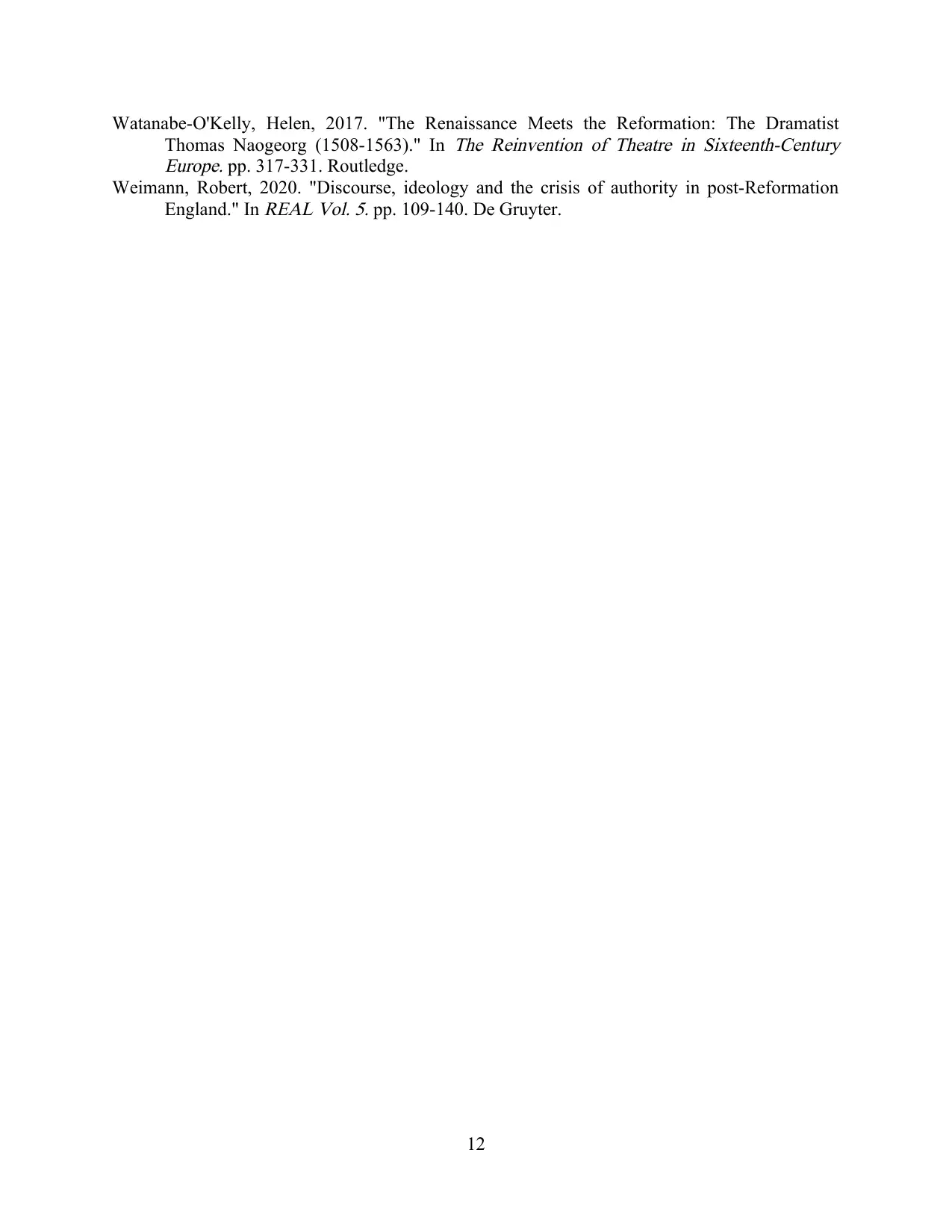
Watanabe-O'Kelly, Helen, 2017. "The Renaissance Meets the Reformation: The Dramatist
Thomas Naogeorg (1508-1563)." In
The Reinvention of Theatre in Sixteenth-Century
Europe. pp. 317-331. Routledge.
Weimann, Robert, 2020. "Discourse, ideology and the crisis of authority in post-Reformation
England." In
REAL Vol. 5. pp. 109-140. De Gruyter.
12
Thomas Naogeorg (1508-1563)." In
The Reinvention of Theatre in Sixteenth-Century
Europe. pp. 317-331. Routledge.
Weimann, Robert, 2020. "Discourse, ideology and the crisis of authority in post-Reformation
England." In
REAL Vol. 5. pp. 109-140. De Gruyter.
12
⊘ This is a preview!⊘
Do you want full access?
Subscribe today to unlock all pages.

Trusted by 1+ million students worldwide
1 out of 12
Your All-in-One AI-Powered Toolkit for Academic Success.
+13062052269
info@desklib.com
Available 24*7 on WhatsApp / Email
![[object Object]](/_next/static/media/star-bottom.7253800d.svg)
Unlock your academic potential
Copyright © 2020–2025 A2Z Services. All Rights Reserved. Developed and managed by ZUCOL.


